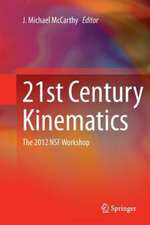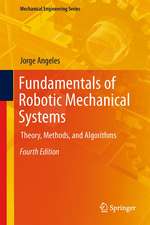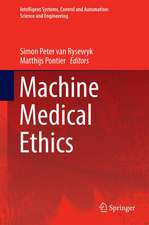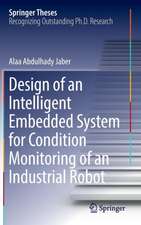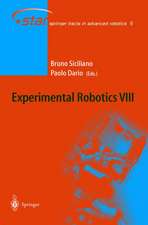Robotic Fabrication in Architecture, Art and Design 2014
Editat de Wes McGee, Monica Ponce de Leon Contribuţii de Aaron Willette Cuvânt înainte de Sigrid Brell-Cokcan, Johannes Braumannen Limba Engleză Hardback – 8 apr 2014
The emerging discourse surrounding robotic fabrication seeks to question the existing norms of manufacturing and has far reaching implications for the future of how architects, artists, and designers engage with materialization processes. This book presents the proceedings of Rob|Arch2014, the second international conference on robotic fabrication in architecture, art, and design. It includes a Foreword by Sigrid Brell-Cokcan and Johannes Braumann, Association for Robots in Architecture. The work contained traverses a wide range of contemporary topics, from methodologies for incorporating dynamic material feedback into existing fabrication processes, to novel interfaces for robotic programming, to new processes forlarge-scale automated construction. The latent argument behind this research is that the term ‘file-to-factory’ must not be a reductive celebration of expediency but instead a perpetual challenge to increase the quality of feedback between design, matter, and making.
| Toate formatele și edițiile | Preț | Express |
|---|---|---|
| Paperback (1) | 794.86 lei 38-44 zile | |
| Springer International Publishing – oct 2016 | 794.86 lei 38-44 zile | |
| Hardback (1) | 956.69 lei 6-8 săpt. | |
| Springer International Publishing – 8 apr 2014 | 956.69 lei 6-8 săpt. |
Preț: 956.69 lei
Preț vechi: 1166.69 lei
-18% Nou
Puncte Express: 1435
Preț estimativ în valută:
183.12€ • 198.98$ • 153.92£
183.12€ • 198.98$ • 153.92£
Carte tipărită la comandă
Livrare economică 21 aprilie-05 mai
Preluare comenzi: 021 569.72.76
Specificații
ISBN-13: 9783319046624
ISBN-10: 3319046624
Pagini: 407
Ilustrații: XIII, 407 p. 294 illus., 233 illus. in color.
Dimensiuni: 155 x 235 x 22 mm
Greutate: 0.77 kg
Ediția:2014
Editura: Springer International Publishing
Colecția Springer
Locul publicării:Cham, Switzerland
ISBN-10: 3319046624
Pagini: 407
Ilustrații: XIII, 407 p. 294 illus., 233 illus. in color.
Dimensiuni: 155 x 235 x 22 mm
Greutate: 0.77 kg
Ediția:2014
Editura: Springer International Publishing
Colecția Springer
Locul publicării:Cham, Switzerland
Public țintă
ResearchCuprins
Preface.- Foreword by the Association.- Scientific Papers.- Projects.- Workshops.- Industry Papers.
Notă biografică
Wes Mcgee is an Assistant Professor at the University of Michigan Taubman College of Architecture and Urban Planning, where he directs research in design and robotic fabrication, as well as a principal in the award winning design firm, Matter Design. Monica Ponce de Leon is the Dean and Eliel Saarinen Collegiate Professor of Architecture and Urban Planning of Taubman College, a registered architect, and principal of the internationally acclaimed Monica Ponce de Leon Studio.
Rob|Arch2014 is supported by The Association for Robots in Architecture, an international organization whose goal is to make industrial robots accessible for the creative industry, artists, designers, and architects, by sharing ideas, research results, and technological developments. The association is founded by Sigrid Brell-Cokcan and Johannes Braumann.
Rob|Arch2014 is supported by The Association for Robots in Architecture, an international organization whose goal is to make industrial robots accessible for the creative industry, artists, designers, and architects, by sharing ideas, research results, and technological developments. The association is founded by Sigrid Brell-Cokcan and Johannes Braumann.
Textul de pe ultima copertă
Robotic automation has become ubiquitous in the modern manufacturing landscape, spanning an overwhelming range of processes and applications-- from small scale force-controlled grinding operations for orthopedic joints to large scale composite manufacturing of aircraft fuselages. Smart factories, seamlessly linked via industrial networks and sensing, have revolutionized mass production, allowing for intelligent, adaptive manufacturing processes across a broad spectrum of industries. Against this background, an emerging group of researchers, designers, and fabricators have begun to apply robotic technology in the pursuit of architecture, art, and design, implementing them in a range of processes and scales. Coupled with computational design tools the technology is no longer relegated to the repetitive production of the assembly line, and is instead being employed for the mass-customization of non-standard components. This radical shift in protocol has been enabled by the development of new design to production workflows and the recognition of robotic manipulators as “multi-functional” fabrication platforms, capable of being reconfigured to suit the specific needs of a process.
The emerging discourse surrounding robotic fabrication seeks to question the existing norms of manufacturing and has far reaching implications for the future of how architects, artists, and designers engage with materialization processes. This book presents the proceedings of Rob|Arch2014, the second international conference on robotic fabrication in architecture, art, and design. The work contained traverses a wide range of contemporary topics, from methodologies for incorporating dynamic material feedback into existing fabrication processes, to novel interfaces for robotic programming, to new processes for large-scale automated construction. The latent argument behind this research is that the term ‘file-to-factory’ must not be a reductive celebration of expediency butinstead a perpetual challenge to increase the quality of feedback between design, matter, and making.
The emerging discourse surrounding robotic fabrication seeks to question the existing norms of manufacturing and has far reaching implications for the future of how architects, artists, and designers engage with materialization processes. This book presents the proceedings of Rob|Arch2014, the second international conference on robotic fabrication in architecture, art, and design. The work contained traverses a wide range of contemporary topics, from methodologies for incorporating dynamic material feedback into existing fabrication processes, to novel interfaces for robotic programming, to new processes for large-scale automated construction. The latent argument behind this research is that the term ‘file-to-factory’ must not be a reductive celebration of expediency butinstead a perpetual challenge to increase the quality of feedback between design, matter, and making.
Caracteristici
Combining papers from industry and university Providing insights into newest developments in robotic industry Shows how advanced interfaces can enhance the interaction between users and complex, kinematic machines Includes supplementary material: sn.pub/extras

